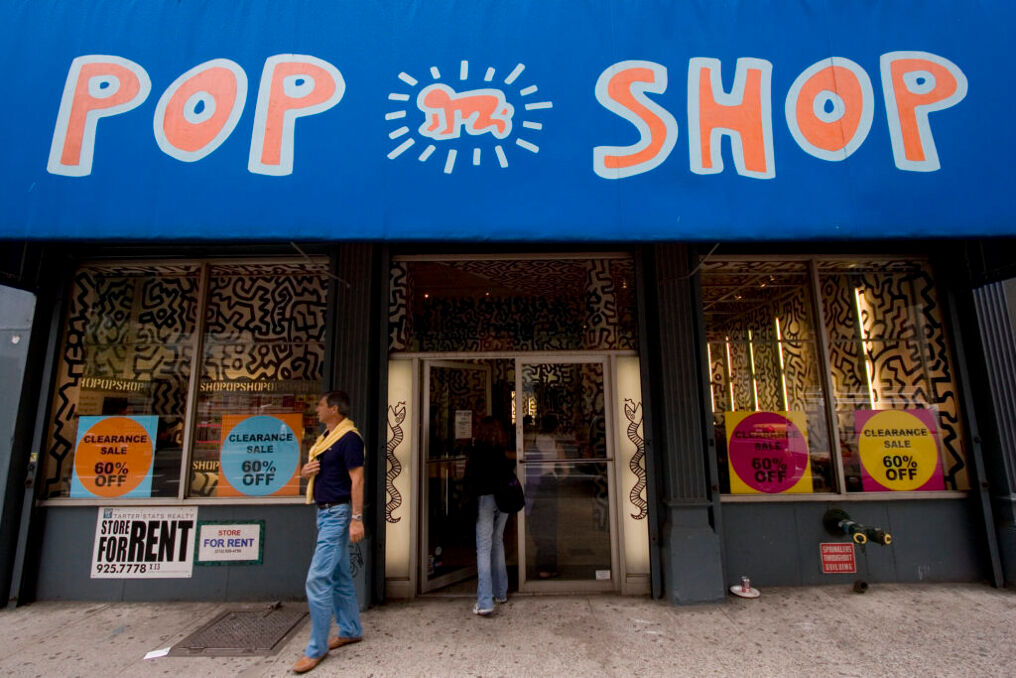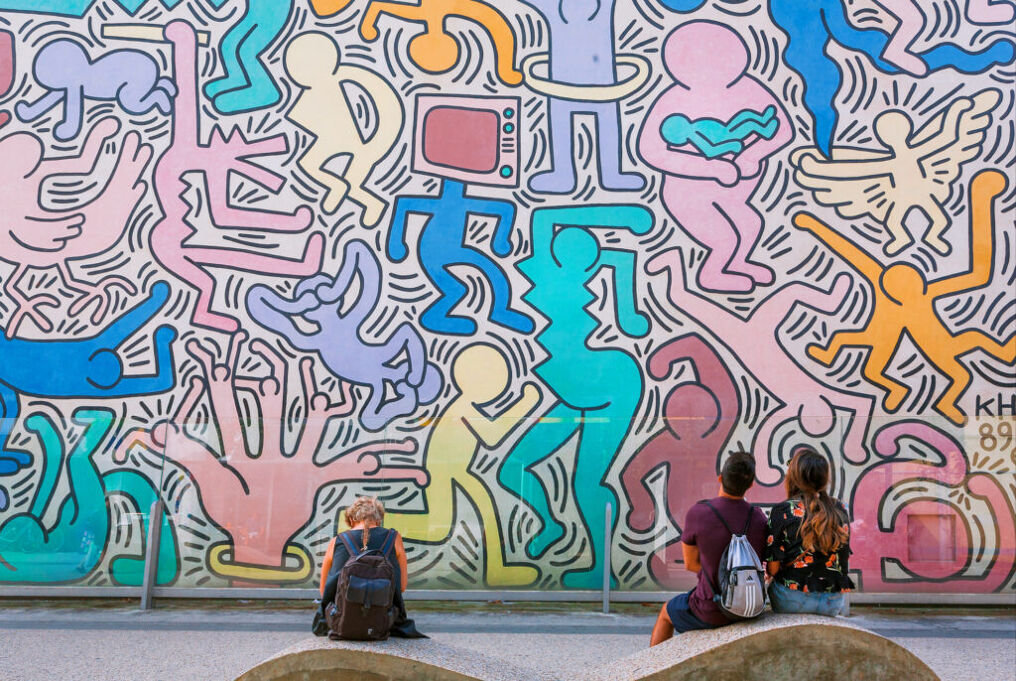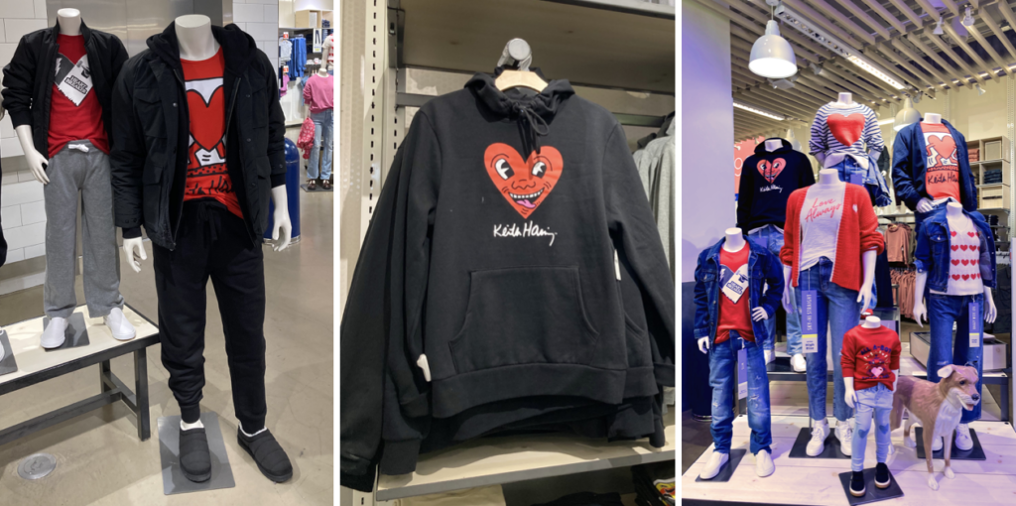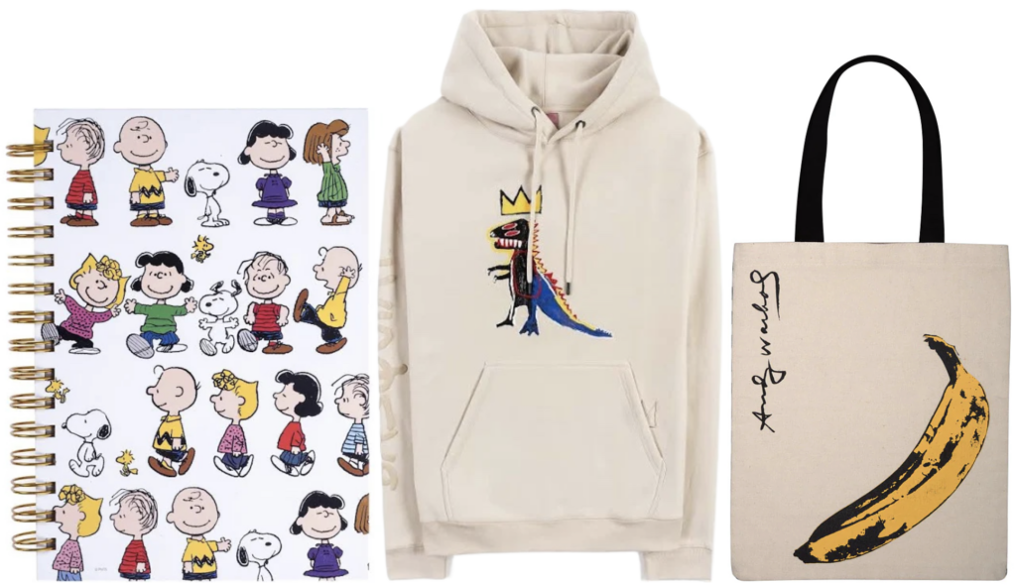Nora Noble was about 20 when a shirt caught their eye. While working at a New York arts camp, Noble noticed a coworker sporting a tee with cartoon-like rainbow figures merrily grooving in a line.
“I thought it was so fun and colorful,” said Noble, now 27 and an educator in South Bend, Indiana.
Curious, they asked their colleague about the design. “And that’s when I found out about Keith Haring,” Noble told INTO.
Noble is one of many queer Gen Zers discovering Haring’s work not in the hallowed halls of museums and cultural institutions but online and in window displays of their go-to retailers. Though born after the famed graffiti artist’s death from AIDS-related complications in 1990, this new generation is fascinated by his artwork — popping with saturated colors, kinetic energy, and bold, black outlines — and finding different entry points to discover the artist behind the art.
Imprinted on everything from area rugs and iPhone cases to study chairs and toy dolls and a newly resurrected amusement park art exhibit, Haring’s unmistakable designs are particularly visible to young shoppers on apparel sold at H+M, Urban Outfitters, and other affordable brands. Such cultural omnipresence makes discovering Haring more accessible, and by wearing an artist known for his loud-and-proud queerness, some Gen Zers better understand their own.
Entertainment with an edge
Whether you’re into indie comics, groundbreaking music, or queer cinema, we’re here to keep you in the loop twice a week.

“Discovering that shirt led me down a rabbit hole of learning more about Haring’s art and the meaning behind a lot of my favorite pieces that I’ve seen from him,” Noble said. “I don’t think my brain immediately picked up on any queer nature of the art; looking at it in retrospect, it feels more blatant to me.”
Noble found something “queer-coded” in “the simplicity, the joy, and the colorfulness of” Haring’s art — visual themes that perhaps subconsciously call Gilbert Baker’s rainbow-striped Pride flag to mind. Interrogating the queer elements of Haring’s more mainstream, licensed works inspired Noble to look into “the meaning behind a lot of my favorite pieces that I’ve seen from him,” they said. “I just saw a fun picture of a dog or people dancing or the baby, but now I have a better understanding of where these paintings came from.”
This curiosity can also stimulate an interest in fine art; when Noble later purchased their own Haring T-shirt, they did so not at a commercial chain but at a Chicago museum featuring hundreds of artists from all walks of life.
From subway stop to Pop Shop

Born in Pennsylvania in 1958, Haring was inspired at a young age by classic cartoonists like Charles Schultz, Dr. Seuss, and Walt Disney animation. Those spirited and jaunty designs would later influence his graffiti art that enlivened New York City subways in the 1980s.
Drawing flying saucers and what became known as the Radiant Baby (an infant on all fours with rays emitting from its body), Haring’s artwork became a defining part of the Metropolitan Transportation Authority’s visual identity. For those who didn’t frequently encounter fine art, Haring gave everyday New Yorkers a way in.
“He wanted to bring the museum to them,” said art dealer Tony Shafrazi in the 2008 documentary The Universe of Keith Haring.
Haring also used his platform to sketch genitalia, saying, “[I was] asserting my sexuality and forcing people to deal with it. I consciously flaunted the fact that I was interested in d**ks because I could.” These efforts and, later, his out-HIV-positive status helped destigmatize homosexuality and AIDS. Still, his 1987 HIV diagnosis came with social consequences.
“I think he was shocked that the party invitations stopped,” Haring’s friend Kenny Scharf, a fellow artist, said.
Still, Haring’s popularity persisted thanks to his Pop Shop, which opened in downtown Manhattan the year before [in 1986] and became another way to widen access to art and his interest in activism. The retail location laid the groundwork for a global phenomenon through licensing agreements with the Keith Haring Foundation, which distributes grants to social service organizations, arts programs, and education.
Through this commercialization, Haring is recognized worldwide, but in New York, his merch inspires Gen Zers to dig deeper into the activist’s creative roots.
How to discover Keith Haring? It depends on where you live

“Growing up in New York, there’s so much Keith Haring content everywhere,” Olivia Osborne, a 19-year-old New Yorker, told INTO.
Osborne purchased a love-themed sticker packet with Haring hearts from New York City’s Museum of Modern Art Design Store; a magenta dancing figure holding a beating heart now decorates her iPhone case.
“I love the way it looks, but it’s also a symbol of something greater: his legacy. He’s one of so many people lost to AIDS. I think it’s important to remember that not so long ago, there were so many people lost to it, and he’s one of them,” Osborne said.

Osborne also recognizes that Haring’s era may have represented a grittier New York. “I don’t see so much art in the Manhattan subways,” Osborne said. Nonetheless, spotting some Haring tees or stickers acts as a reminder of his life and work.
“Clothing is something that other people see: you wear that out into the world, that’s how you present yourself,” Osborne said. “Even if the people who are wearing Haring don’t know what it means, it does keep him alive.”
But accessing queer artists may be easier in some states than in others. In April 2023, Florida expanded its “Don’t Say Gay” law, essentially banning the discussion of sexual orientation and gender identity through 12th grade. The internet, though, has no boundaries.
Related:
What Does Queer Gen Z Want on TV? Everything Under the Rainbow
INTO asked Gen Zers how they want to see their lives portrayed. And regardless of the genre, authenticity reigns supreme.
After tweeting a picture of himself in a white sweater with various black Haring designs, Tony Garrido received over 100 comments.
“need that jumper!” one user on X wrote.
“It’s from H&M:)” replied Garrido, a 20-year-old digital media design student at Florida Gulf Coast University.

Haring may be discovered through street fashion, social media, and budget shopping, but for Garrido, a teacher first discussed the artist in the classroom.
“I first learned about Haring in middle school when we had to do these paintings inspired by him and his work,” Garrido told INTO. That was “about 2015 — a while before all of this ‘Don’t Say Gay’ stuff came out.”
“My area has a lot of conservatives,” Garrido said of growing up in Lee County, Florida, just south of Fort Myers. Even so, he learned about Haring in “art class, and that’s where all the gays are. It was always a place where people could be more open-minded.”
Without exposure to queer artists or the LGBTQ community’s historical impact, young learners lose opportunities to understand a part of themselves better. To date, four more states have passed similar legislation, which the freedom of expression nonprofit Pen America describes as “educational intimidation.” Not just impacting LGBTQ+ youth, such erasure can hinder everyone’s access to art and learning.
“I’ve seen a lot of people who I assume are straight wearing his stuff,” Garrido said. “[Haring’s designs] are applicable to anyone, not just the LGBT community. His artwork is so popular that maybe someone discovers that they like his stuff and Google him to find out more.”
Donning a Haring sweatshirt becomes more than just a fashion statement or a vehicle for social media engagement. Garrido, who identifies as gay, sees Haring’s clothing as a testament to the artist’s enduring legacy. He appreciates that, through the hyperglobal economy of Haring sales, “queer artists are shown in more mainstream areas.”
Nearly 40 years later, how much has changed?

Appreciating Haring’s work but not necessarily knowing who he was is not unique to a single generation. While New Yorkers in the 1980s lived alongside Haring and saw his subway graffiti, “they didn’t necessarily know who was making these things, but they liked the look of it — it’s cheerful,” Natalie Phillips, associate professor of art history at Ball State University, told INTO.
Phillips notes that this isn’t the only similarity between the 1980s and 2020s.
Both eras have been dominated by “two conservative celebrities,” Phillps says, referencing former presidents Ronald Reagan and Donald Trump, who each marginalized queer communities in their own way. Reagan’s silence during the AIDS crisis led to 1987’s “Silence=Death” political art-making project, from which Haring found inspiration. Trump’s repeated attempts to ban transgender individuals from serving in the military and a continued “timeline of hate,” as described by the Human Rights Campaign, fail to damper the next generation of queer artists.
Additionally, “The trauma of disease in the 80s was the AIDS crisis, and our students are still traumatized by COVID,” Phillips said. “That’s not an exact parallel, but that fear of disease stoked our bigotry. With AIDS, it was homophobia, but with COVID, it’s different circumstances, but led to racism against Asian Americans.”
Phillips believes young people finding Haring today may feel a kinship with the artist, propelling some to wear his work and express a shared identity. Gen Zers may sense that “this guy could have been me, but 40 years ago.”
When art and commerce collide

As his popularity grew, Haring’s Pop Shop enabled him to produce and sell his art on his terms while making it more accessible. “I had to go with that idea and let it happen,” Haring said, “let it become part of the culture, let it become part of the mass culture instead of taking it back into the art world and hiding in the art world, which is where I was trying to break out of in the first place.”
Reporting on the Pop Shop opening in 1986, The New York Times noted no dressing rooms; the store was not meant to be a fancy atelier where customers perused designs for a bespoke fit. Speaking with the Times, Haring said the shop is “our version of fast food or fast art.”
Today, sold through international brands like Gap and Uniqlo, Haring’s work has become a part of the fast fashion machine, appearing alongside works by Andy Warhol, Jean-Michel Basquiat, and even his early inspiration, Charles Schulz’s Peanuts.

“My initial reaction when I see these shirts at Target is cringy,” Phillips said. “Like, I don’t know about that, but you think back to Keith Haring, and that’s what he wanted: he wanted to bring art to the average person on the subway, to the Target consumer who could afford to buy it, and I respect that.”
For some buyers, queerness is incongruous with capitalism, even as it has no choice but to exist within it.
“I could imagine a terrible world in which the Target Pride collection has the phallic Keith Haring art on its shirts,” Lex Podell, a 27-year-old in Chicago, told INTO.
His tongue-in-cheek comment proposes that once queer art becomes mainstream or overly commercialized, it loses some of its edge, even if it economically benefits the artist.
“I have had a couple different Keith Haring shirts,” Podell said. “I think they’ve all been purchased on sale or clearance, and my excuse [for buying them] is so a straight person won’t buy and wear them.”
Despite the joke, Podell acknowledges he likely discovered Haring’s work through a purchase. “It ends up sort of being a wash,” he said. “A lot of these stores are fast fashion and rely on a lot of labor exploitation not only in other countries but also the retail employees selling it, but it does enable people who don’t know about him — I can imagine people getting a shirt saying, ‘Hey, I love this Radiant Baby, let me find out more about this artist.’ From a knowledge standpoint, it’s probably beneficial.”
Plus, as Phillips said, “There’s no reason that artists have to be starving; they have to make a living.”
And Haring did: “I’ve been paying rent for about a year and working on merchandise,” he had told the Times in the 1986 interview only a few years before his passing. “And it’s all done with my own money.” During his lifetime and brief but meteoric career, a canvas could sell for upwards of $350,000. Since his passing, the top price at auction has exceeded $6 million.
Wearing queer art, especially notable queer art, can act as a signifier that you are not alone in this world.
Nora Noble
Such enduring legacy and global success can prove lucrative for retail corporations; at the same time, they’ll pull LGBTQ+ products if their sale proves controversial and threaten their reputation — and profit. Last year, Target quietly removed some of its LGBTQ+ merchandise a few days before June 1 after facing backlash from conservative customers over the company’s choice to celebrate Pride Month.
In such a climate, donning a queer artist’s work can act as a lighthouse, signaling the wearer’s politics and identity. For Noble, this can have a tangible impact.
“Wearing queer art, especially notable queer art, can act as a signifier that you are not alone in this world,” they said.
The wearing of a Haring piece, then, for Noble, can signal “an allyship: we have something in common, and I support this, and I support you,” they said, “which I think is very important in the world that we live in — to try and reconnect with each other in a world that feels so separate.”♦
Help make sure LGBTQ+ stories are being told...
We can't rely on mainstream media to tell our stories. That's why we don't lock our articles behind a paywall. Will you support our mission with a contribution today?
Cancel anytime · Proudly LGBTQ+ owned and operated














